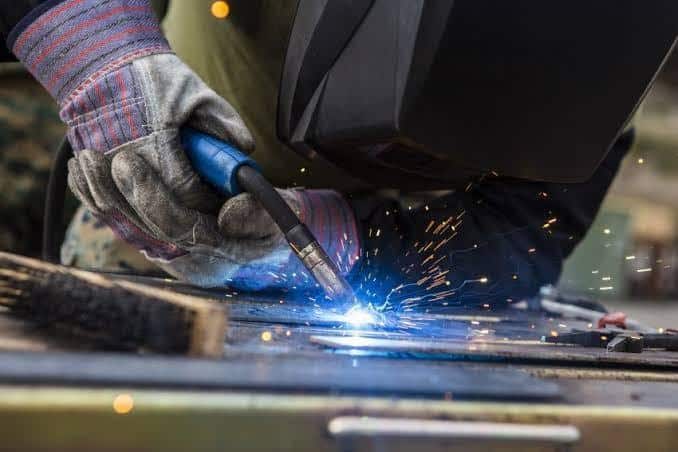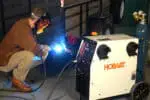MIG welding is one of the most prevalent types of welding. Metal inert gas (MIG) welding, commonly known as gas metal arc welding (GMAW), is a form of welding that unites two metals using an arc welding method.
This welding process uses a shielding gas to prevent the molten pool of weld metal from reacting with components in the environment, resulting in a higher-quality weld on the completed product.
There are, however, gasless options for MIG welding. Each method has its own filler wire, although the welding procedure is nearly identical between the two.
There are certain advantages of gasless MIG welding. Also known as self-shielding flux core welders, this technique can fuse thicker metal than gas MIG welders, including metal with rust, dirt, paint, and so on.
They are more portable, give you increased productivity, and may be utilised outside or in windy situations without polluting the weld pool.
But what is this MIG gasless welding technique?
To weld gasless, you must use the appropriate flux-cored filler wire. It’s similar to MIG welding with a stick electrode in that a protective slag layer grows over the metal to protect it from impurities. It is possible to claim that gasless welding is not technically gasless.
As the flux within the wire melts, it emits vapors to protect the pool, which bubbles to the surface and forms slag over the weld.
Because there is no need for a gas cylinder, gasless welding is sometimes known as self-shielded welding.
How is MIG gasless welding different from MIG gas welding?
There are a few fundamental differences between gas MIG welders and gasless MIG welders. Both employ the MIG (metal inert gas) welding technique.
Because of the nature of MIG welding, a shielding material is required to avoid corruption, which is the primary difference between gas and gasless MIG welding.
→ To protect the weld, gas MIG welding (also known as GMAW or Gas Metal Arc Welding) employs shielding gas from a tank or cylinder that is supplied into the welding gun along with a wire.
→ Gasless MIG welding (also known as FCAW or Flux Core Arc Welding) replaces shielding gas with a self-shielding flux core wire throughout the welding process.
Gas and gasless MIG welders have distinct capabilities, such as where they may be utilized and what type and thickness of metal they can weld.
Things to remember while using gasless MIG welding technique
The use of gasless MIG welding is becoming more widespread than ever. The advantages are clear for jobs that require moving about or working in small places. Simply said, not having to transport a gas cylinder is far more convenient.
1.) Use your gasless MIG welder outdoors or in a well-ventilated room.
When you don’t have an external gas cylinder, it’s simpler to operate in compact places, which is one of the many advantages of gasless welding.
However, this poses its own set of issues, particularly when compact places have inadequate ventilation. This is a major issue since gasless welders emit a lot of fumes.
This generates an uncomfortable working atmosphere which can be quite unsafe too. Exposure to fumes might potentially create health concerns in the long run. As a result, it’s critical to take care when using a gasless welder.
2.) Make use of a voltage sensing wire feeder.
Outdoor applications are also common for gasless MIG welding. Many farmers, for example, choose gasless welders for fixing fences on their land since they are more portable.
Gasless welders, on the other hand, do not always function well with external generators.
Many portable generators provide variable voltage and steady current. Because various gauges of self-shielding wire demand varied currents, this is not suitable for gasless welding.
It is advisable to utilize a voltage detecting wire feeder to avoid this issue. Even with a continuous current source, you can regulate the current going to your welding torch.
3.) Choose the correct welding polarity
The first thing you should know is that not all welders can work with self-shielding wire. This is due to the fact that welding torches must have the proper polarity for the type of wire being used.
Fortunately, there are only three types of welding polarity to consider:
DC Straight- An electrical current travels from the electrode to the welding surface, causing substantial heat to be generated on the welding surface.
DC Reverse- An electrical current passes from the welding surface to the electrode, focusing heat on the electrode.
Alternating- In this case, the current’s direction alternates. This is most commonly employed in big industrial applications.
A welding gun with DC reverse polarity is required for a gasless MIG welder.
Straight polarity with self-shielding wire yields poor performance. This will usually result in a lot of spatter around the connection. This is best avoided if you want your joints to seem as clean as possible.
4.) Preventing porosity and worm tracking
Self-shielding wire causes various issues that external gas shielding does not. This may be both visible and structural. In any instance, merely being aware of them is frequently sufficient to avert them.
The first characteristic is porosity. Essentially, this occurs when pockets of gas generated by the flux become trapped in the joint. As a result, you’ll have weak spots along your welding surface.
Before welding, properly clean the surface to avoid porosity. This involves cleaning the surface of any dirt. It’s also a good idea to restrict your electrode extension to less than 3cm.
Worm tracking is the second issue. This is the term used to describe the markings left by flux gas on the surface of your welding joint. Worm tracking will not occur if the criteria specified by the wire’s manufacturer are followed.
But if it did occur, it is critical to lower your voltage setting.
To determine the appropriate voltage, use a test piece and lower your voltage in half-volt increments until the problem is resolved.
The main advantage of gasless MIG welding is that it does not require the use of industrial shielding gas, which saves you a lot of money on cylinder rental costs.
Shielding gases are expensive, and if you don’t conduct a lot of MIG welding, keeping a cylinder in your garage or shop is pricey on a monthly or yearly basis.
5.) Select the optimum angle of travel and travel speed
Even the most experienced welders may struggle to transition from gas-shielded to self-shielded welding. Old habits, like any other, are difficult to break. This is also true when it comes to fine-tuning your welding method.
Gas welders function better in a narrower range of attack angles due to the larger concentration of heat on the electrode. The best range of angles for vertical welding is 5-15 degrees. This is 15-40 degrees for horizontal welding.
When welding using self-shielding wire, it is also critical to maintain a steady travel speed. Again, the high concentration of heat on the electrode might induce puddling and slag on your welding surface. It is critical to keep the flame moving in order to avoid this.
Now let’s talk about the advantages and disadvantages of gasless MIG welding.
As with other welding procedures, there are pros and drawbacks to consider when deciding if gasless MIG welding is a viable option.
Among the benefits of gasless MIG welders are:
1.) Outdoors or in windy weather, it can be employed.
2.) Portable MIG welders use less equipment than gas MIG welders.
3.) Welds metal that has been contaminated by dirt, rust, paint, or other particles.
4.) Thicker metal may be easily welded with good penetration.
5.) Useful in all roles (with proper filler material).
6.) Productivity and deposition rate are both high.
The following are some disadvantages of gasless MIG welders:
1.) They emit more fumes than gas MIG welders.
2.) Spatter and slag are produced and must be cleaned.
3.) Welding thin metals is not recommended.
4.) Difficult to achieve in vertical and above locations.
See also: Best MIG Welder for the Automotive Exhaust Shop
Conclusion
Gasless MIG welders have various benefits, including the ability to create strong, high-quality welds, the ability to repair, manufacture, and weld thicker metals, and the fact that they are more portable and handy than gas MIG welders.
Because of their great productivity, efficiency, and overall lower equipment cost, they are becoming more extensively employed.
However, welding thin metals using gasless MIG welders is not advised owing to their increased penetration, and they are slightly limited in the type of metal that may be welded.
But the mobility of gasless MIG welding, as well as its ability to be done in windy situations, makes it perfect for outside repairs, particularly in agriculture.







